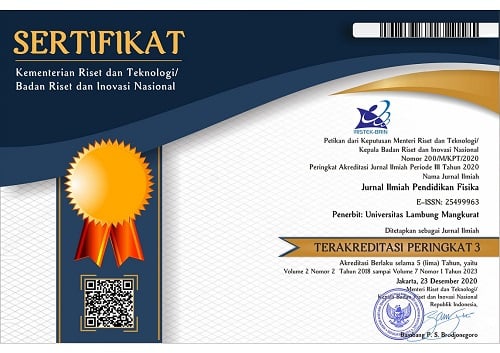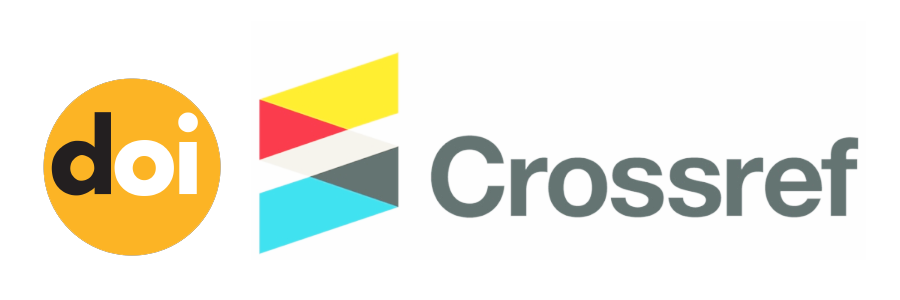Validity of Physics Module Development in Electronics Subject Project-Based Operational Amplifier Material
Abstract
This study aims to develop teaching materials in physics learning modules in project-based operational amplifier material electronics courses that are valid for use. This type of research is development research with a research and development method and a 4-D development model that includes four stages: define, design, develop, and disseminate. However, this research is limited to the development stage. The test subjects in this study were two validators, material expert validators and media experts. The data collection instrument is a validated questionnaire. The results of the questionnaire obtained from this development research are as follows: (1) The validity of the physics module in the project-based operational amplifier material electronics course is declared very valid with a percentage of (85%) in terms of material aspects. (2) The validity of the physics module in the project-based operational amplifier material electronics course is declared very valid, with a percentage value of 86% in terms of media aspects. So, it can be concluded that the physics learning module in the project-based operational amplifier material electronics course is valid for use as teaching material. This study implies that the module developed can serve as a supplement to educational activities.
Keywords
Full Text:
PDFReferences
Adeliya P, H. (2021). Perkembangan kurikulum pendidikan indonesia dari masa ke masa. Sindang. 3(2).
Akbar, S. (2013). Instrumen perangkat pembelajaran. Remaja Rosdakarya.
Akker, J. van den, Bannan, B., Kelly, A. E., Nieveen, N., & Plomp, T. (2020). An introduction to educational design research (T. Plomp & N. Nieveen (eds.)). Educational Design Research.
Alammary, A., Sheard, J., & Carbone, A. (2014). Blended learning in higher education: Three different design approaches. Australasian Journal of Educational Technology, 30(4).
Arsad, A. (2017). Media pembelajaran (A. Rahman (ed.); 20th ed.). Rajawali Pers.
Basu, D., Lohani, V. K., & Xia, K. (2019). Analysis of students’ personalized learning and engagement within a cyberlearning system. ASEE Annual Conference and Exposition, Conference
Bogard, T., & Carr-Chellman, A. (2017). Instructional design models. The Journal of Applied Instructional Design, 12(1).
Collison, G., Elbaum, B., Haavind, S., & Tinker, R. (2020). Memfasilitasi pembelajaran online: Strategi Efektif untuk moderator. (Revised Ed). Atwood Publishing.
Dempsey, J., & Van Eck, R. (2018). Instructional design:Priciples and applications (L. J. Briggs, K. L. Gustafson, & M. H. Tillman (eds.); Second Edi). Educational Technology Publications.
Fatikhah, I., & Izzati, N. (2015). Matematika bermuatan emotion quotient pada pokok bahasan himpunan. EduMa, 4(2), 46–61.
Hanushek, E. A., & Woessmann, L. (2008). Role-cog-skills-econ-dev. Journal of Economic Literature, 46(3), 607–668.
John W. T. P. D. (2018). A revieuw of of research on projeect based learning. International Geology Review, 63(1), 47–64.
Kapur, M. (2014). Productive failure in learning math. Cognitive Science, 38(5), 1008–1022.
Khasanah, A., & Sunarti, T. (2017). Pengembangan lembar kerja siswa (lks) menggunkan metode addie pada materi gerak lurus di man surabaya. Jurnal Novasi Pendidikan Fisika, 5(3), 45–48.
Khoirurrijal, K., Fadriati, F., Sofia, S., Anisa, D. M., Sunaryo, G., Abdul, M., Tajeri, T., Ali, F., & Hamdani, S. (2022). Pengembangan kurikulum merdeka (cetakan 1). CV. Literasi Nusantara Abadi, Malang.
Mahendra, I. W. E. (2017). Project based learning bermuatan etnomatematika dalam pembelajar matematika. JPI (Jurnal Pendidikan Indonesia), 6(1), 106–114.
Malik, M. S., & Sukiman. (2021). Development and implementation of curriculum adaption during the covid-19. Jurnal Penelitian Pendidikan Islam, 16(1), 125–146.
Manalu, J. B., Sitohang, P., Heriwati, N., & Turnip, H. (2022). Pengembangan perangkat pembelajaran kurikulum merdeka belajar.Prosiding Pendidikan Dasar, 1, 80–86.
Morrison, G. R., Ross, S. M., & E, J. (2017). Designing effective instruction (6th Editio). New York: John Wiley & Sons.
Muhardini, S., Sudarwo, S., Anam, K., Bilal, A. I., Mayasari, D., Haifaturrahmah, H., ... & Ibrahim, I. (2023). Pelatihan implementasi kurikulum merdeka dalam pengembangan perangkat pembelajaran di gugus 5 kota mataram. SELAPARANG: Jurnal Pengabdian Masyarakat Berkemajuan, 7(2), 839-843.
Parmin, P., & Peniati, E. (2012). Pengembangan modul mata kuliah strategi belajar mengajar ipa berbasis hasil penelitian pembelajaran. Jurnal Pendidikan IPA Indonesia, 1(1), 8–15.
Richey, R. C., Klein, J. D., & Tracey, M. W. (2019). The instructional design knowledge base (First Edit). Routledge.
Risan, R., & History, A. (2022). Identifying the characteristics of the student : An evaluation for english teachers pedagogical competence. Journal of English Language Teaching, 11(2), 147–159.
Rockinson- Szapkiw, A. J., Courduff, J., Carter, K., & Bennett, D. (2013). Electronic versus traditional print textbooks: A comparison study on the influence of university students’ learning. Computers and Education, 63(January), 259–266.
Sadiq, S., & Zamir, S. (2014). Effectiveness of modular approach in teaching at university level effectiveness of modular approach in teaching at university level. Journal of Education and Practice, 5(17), 103–110.
Sari, R. T., & Angreni, S. (2018). Penerapan model pembelajaran project based learning (pjbl) upaya peningkatan kreativitas mahasiswa. Jurnal VARIDIKA, 30(1), 79–83.
Septi, S., Sakti, I., & Putri, D. H. (2019). Pengembangan modul fisika dengan pembelajaran berbasis proyek pada materi alat-alat optik. Jurnal Kumparan Fisika, 2(3), 129–136. 9-136
Sugiyono, S. (2018). Metode penelitian kuantitatif. Alfabeta.
Taherdoost, H. (2020). Different types of data analysis ; Data analysis methods and techniques in research projects. International Journal of Academic Research in Management (IJARM), 9(1), 1–9.
Thiagarajan, S., Semmel, D. S., Semmel, M. (1974). Instructional development for training teachers of exceptional children. Central for Innovation on Teaching The Handicapped.
Tohir, A., Herpratiwi, H., & Rudibyani, R. B. (2015). Pengembangan bahan ajar modul kesetimbangan kimia berbasis multipel representasi di sma kota bandar lampung. Teknologi Informasi Komunikasi
Pendidikan, 3 No. 3(1), 5–24.
Tomlinson, C. A. (2017). The rationale for differentiating instruction in academically diverse classrooms. In Differentiate Instruction : in Academically Diverse Classooms.
Waryanto, N. H., Bambang, S. H. M., Kuswari H, & Emut, N. I. (2017). Training of interaktive electronic book. Jurnal Pengabdian Masyarakat MIPA dan Pendidikan MIPA, 1(1), 33–40.
Woody, W. D., Daniel, D. B., & Baker, C. A. (2010). E-books or textbooks: Students prefer textbooks. Computers & education, 55(3), 945-948.
DOI: https://doi.org/10.20527/jipf.v8i2.12423
Refbacks
- There are currently no refbacks.
Indexed by: Jurnal Ilmiah Pendidikan Fisika is licensed under a creative commons attribution-share alike 4.0 international license
Statistics Counter |
















